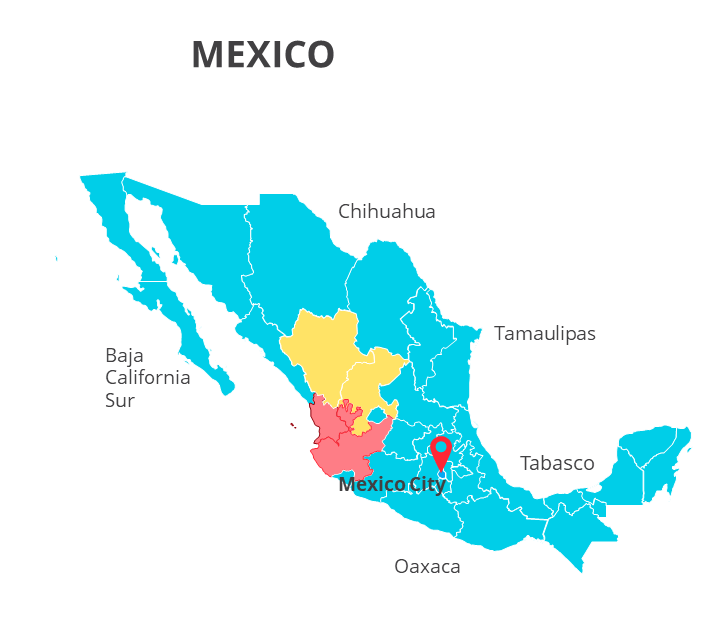– Wixáritari
Guardians of Tradition
Wixáritari People
The Huichol, or Wixáritari in their native language, are an indigenous group residing in the remote regions of Mexico’s Sierra Madre Occidental. Renowned for their vibrant spiritual practices and exquisite artistry, the Huichol have safeguarded their cultural heritage for centuries.
Cultural Richness: Central to Huichol life is a deep reverence for nature and the spiritual realm. Their traditional beliefs intertwine with daily existence, guiding everything from agricultural practices to artistic expression. Rituals involving peyote, a sacred cactus, play a significant role in their spiritual ceremonies, fostering a profound connection to the divine and the natural world.
Artistic Mastery: Huichol art is globally celebrated for its intricate beadwork, yarn paintings, and sculptures. Each piece is imbued with symbolic meaning, reflecting the Huichol’s cosmology, mythology, and connection to the land. Their vibrant creations not only adorn their ceremonial objects and clothing but also serve as a medium for storytelling and spiritual communication.
Community and Traditions: Huichol society revolves around communal living and collective decision-making. Strong bonds within families and communities sustain their way of life, characterized by mutual support and shared responsibilities. Traditional governance structures, led by shamans and elders, uphold cultural practices and resolve disputes in accordance with ancestral wisdom.
Challenges and Resilience: Despite their resilience and cultural pride, the Huichol face ongoing challenges, including land encroachment, economic disparities, and limited access to education and healthcare. Yet, through advocacy efforts and cultural revitalization initiatives, they continue to assert their rights and preserve their ancestral heritage for future generations.
Legacy and Future: The Huichol’s legacy is one of resilience, creativity, and spiritual depth. As they navigate the complexities of the modern world, they remain steadfast in their commitment to honoring their traditions, protecting their lands, and ensuring the continuity of their unique cultural identity.
Regions They Inhabit
 The Huichol people, known as the Wixaritari, inhabit a region rich in natural beauty and cultural history in Mexico. Their traditional territories span several states, each contributing to the unique environment that shapes their way of life and artistic expressions. These states include Jalisco, Nayarit, Zacatecas, and Durango.
The Huichol people, known as the Wixaritari, inhabit a region rich in natural beauty and cultural history in Mexico. Their traditional territories span several states, each contributing to the unique environment that shapes their way of life and artistic expressions. These states include Jalisco, Nayarit, Zacatecas, and Durango.
Jalisco
Jalisco is one of the primary states where the Huichol people live. This region is characterized by its diverse landscapes, ranging from coastal areas to mountainous regions. In Jalisco, the Huichol communities are primarily found in the Sierra Madre Occidental, a mountain range that provides a remote and rugged home. The state’s varied ecosystems offer an abundance of natural resources that are central to the Huichol way of life, including materials for their traditional crafts and food sources for sustenance.
Nayarit
Nayarit is another significant state for the Huichol people. This state features a combination of coastal plains and mountainous areas. The Sierra de Nayarit, part of the Sierra Madre Occidental, is where many Huichol villages are located. The region’s rich biodiversity and fertile land are integral to their agricultural practices and spiritual traditions. The Huichol in Nayarit are known for their vibrant community life and the preservation of their cultural practices, including ceremonies and festivals that celebrate their deep connection to nature.
Zacatecas
In Zacatecas, the Huichol people reside mainly in the northern parts, where the landscape is characterized by high plateaus and mountain ranges. This area is less densely populated, providing the Huichol with a secluded environment where they can maintain their traditional lifestyle. The natural resources of Zacatecas, such as its forests and rivers, play a crucial role in the Huichol’s daily life and their artistic creations, particularly their renowned yarn paintings and beadwork.
Durango
Durango is also home to a portion of the Huichol population, particularly in the southwestern regions that intersect with the Sierra Madre Occidental. This state is known for its dramatic landscapes, including extensive forests and mountain ranges. The Huichol communities in Durango benefit from the rich natural resources available in this region, which support their agricultural activities and provide materials for their traditional crafts.
Cultural and Environmental Significance
The diverse environments of these states not only support the Huichol’s physical needs but also influence their spiritual and cultural practices. The Sierra Madre Occidental, with its remote and rugged terrain, offers a sanctuary where the Huichol can continue their traditional way of life relatively undisturbed by modern influences. This isolation has helped preserve their language, religious practices, and artistic traditions.
The natural beauty and resources of Jalisco, Nayarit, Zacatecas, and Durango are integral to the Huichol’s identity. From the vibrant yarn paintings that depict their cosmology to the sacred rituals that honor their deities, the Huichol’s connection to their land is evident in every aspect of their culture.
In summary, the Huichol people’s homeland spans the states of Jalisco, Nayarit, Zacatecas, and Durango. Each region contributes to the rich tapestry of their cultural heritage, providing the resources and environment necessary to sustain their traditional lifestyle and artistic expressions.